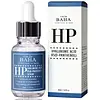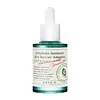What's inside
What's inside
 Key Ingredients
Key Ingredients

 Benefits
Benefits

 Concerns
Concerns

No concerns
 Ingredients Side-by-side
Ingredients Side-by-side

Aloe Barbadensis Leaf Extract
EmollientPropanediol
SolventGlycerin
HumectantPantothenic Acid 4%
Skin ConditioningNiacinamide
Smoothing1,2-Hexanediol
Skin ConditioningBetaine
HumectantSodium Hyaluronate
HumectantAllantoin
Skin ConditioningRosa Damascena Extract
MaskingLavandula Angustifolia Flower Extract
CleansingCamellia Sinensis Leaf Extract
AntimicrobialMelissa Officinalis Leaf Extract
Skin ConditioningArtemisia Vulgaris Extract 72%
Skin ConditioningAloe Barbadensis Leaf Extract, Propanediol, Glycerin, Pantothenic Acid 4%, Niacinamide, 1,2-Hexanediol, Betaine, Sodium Hyaluronate, Allantoin, Rosa Damascena Extract, Lavandula Angustifolia Flower Extract, Camellia Sinensis Leaf Extract, Melissa Officinalis Leaf Extract, Artemisia Vulgaris Extract 72%
Water
Skin ConditioningAloe Barbadensis Leaf Water
MaskingButylene Glycol
HumectantSodium Hyaluronate
HumectantCentella Asiatica Extract
CleansingGlycerin
HumectantBetaine
HumectantPropanediol
SolventGlycyrrhiza Uralensis Root Extract
Skin ConditioningHieracium Umbellatum Extract
Skin ConditioningCynara Scolymus Leaf Extract
Skin ConditioningSorbitol
HumectantAloe Barbadensis Leaf Extract
EmollientDioscorea Japonica Root Extract
Skin ConditioningLaminaria Japonica Extract
Skin Protecting1,2-Hexanediol
Skin ConditioningXanthan Gum
EmulsifyingCarbomer
Emulsion StabilisingLinum Usitatissimum Seed Extract
PerfumingHibiscus Esculentus Fruit Extract
Skin ConditioningAloe Barbadensis Leaf Juice
Skin ConditioningArctium Lappa Root Extract
Skin ConditioningHibiscus Mutabilis Flower Extract
Skin ConditioningCorchorus Olitorius Leaf Extract
Skin ConditioningRheum Palmatum Root Extract
AstringentAlthaea Rosea Flower Extract
Skin ConditioningDimethyl Sulfone
SolventChlorphenesin
AntimicrobialEthylhexylglycerin
Skin ConditioningPolyglutamic Acid
Skin ConditioningBeta-Glucan
Skin ConditioningArginine
MaskingAllantoin
Skin ConditioningAdenosine
Skin ConditioningWater, Aloe Barbadensis Leaf Water, Butylene Glycol, Sodium Hyaluronate, Centella Asiatica Extract, Glycerin, Betaine, Propanediol, Glycyrrhiza Uralensis Root Extract, Hieracium Umbellatum Extract, Cynara Scolymus Leaf Extract, Sorbitol, Aloe Barbadensis Leaf Extract, Dioscorea Japonica Root Extract, Laminaria Japonica Extract, 1,2-Hexanediol, Xanthan Gum, Carbomer, Linum Usitatissimum Seed Extract, Hibiscus Esculentus Fruit Extract, Aloe Barbadensis Leaf Juice, Arctium Lappa Root Extract, Hibiscus Mutabilis Flower Extract, Corchorus Olitorius Leaf Extract, Rheum Palmatum Root Extract, Althaea Rosea Flower Extract, Dimethyl Sulfone, Chlorphenesin, Ethylhexylglycerin, Polyglutamic Acid, Beta-Glucan, Arginine, Allantoin, Adenosine
 Reviews
Reviews

Ingredients Explained
These ingredients are found in both products.
Ingredients higher up in an ingredient list are typically present in a larger amount.
1,2-Hexanediol is a synthetic liquid and another multi-functional powerhouse.
It is a:
- Humectant, drawing moisture into the skin
- Emollient, helping to soften skin
- Solvent, dispersing and stabilizing formulas
- Preservative booster, enhancing the antimicrobial activity of other preservatives
Allantoin is a soothing ingredient known for its protective and moisturizingg properties. Because of this, it is often added to products with strong active ingredients.
Studies show higher concentrations of this ingredient can promote wound healing.
Though it can be derived from the comfrey plant, allantoin is produced synthetically for cosmetic products to ensure purity.
Learn more about AllantoinAloe Barbadensis Leaf Extract is an extract of the leaves of the aloe, Aloe barbadensis, Liliaceae.
Aloe is one of the most well-known natural soothing ingredients, and for good reason. It’s full of water and has a cooling, calming effect on the skin, especially when it’s sunburned, itchy, or irritated. Aloe also helps your skin stay hydrated and smooth by mimicking what healthy skin naturally produces. On top of that, it contains vitamins and nutrients that support skin recovery.
It doesn’t protect you from the sun, but it can help your skin bounce back after too much time in it.
Let’s get into the details:
Aloe contains antioxidant Vitamins A, C, and E, which help fight off free radicals (unstable molecules from things like pollution that can damage your skin).
It’s also rich in polysaccharides, which are natural sugars that help hydrate the skin by acting like the skin’s own moisturizing agents. These, along with other sugars like monosaccharides, help form a protective barrier that locks in moisture.
Aloe works as both a humectant and an emollient. That means it draws water into the skin (humectant) and helps trap it there (emollient), making it an effective natural moisturizer.
You’ll also find a mix of other skin-supporting ingredients in aloe, including folic acid, choline, calcium, amino acids, fatty acids, and even Vitamin B12.
Out of the 420+ species of aloe, Aloe barbadensis is the most widely used in skincare products thanks to its gentle yet effective properties.
There are over 420 species of aloe but Aloe Barbadensis is the most commonly used for topical products.
Learn more about Aloe Barbadensis Leaf ExtractBetaine is a common humectant (a substance that promotes retention of moisture). It's known to be gentle on the skin and can help balance hydration.
This ingredient is best for improving hydration and soothing irritated skin. Studies also show it helps even out skin tone.
Fun fact: Betaine is naturally created in the skin and body. The kind found within cosmetic products can be either plant-derived or synthetic.
Another name for betaine is trimethylglycine.
Learn more about BetaineGlycerin is already naturally found in your skin. It helps moisturize and protect your skin.
A study from 2016 found glycerin to be more effective as a humectant than AHAs and hyaluronic acid.
As a humectant, it helps the skin stay hydrated by pulling moisture to your skin. The low molecular weight of glycerin allows it to pull moisture into the deeper layers of your skin.
Hydrated skin improves your skin barrier; Your skin barrier helps protect against irritants and bacteria.
Glycerin has also been found to have antimicrobial and antiviral properties. Due to these properties, glycerin is often used in wound and burn treatments.
In cosmetics, glycerin is usually derived from plants such as soybean or palm. However, it can also be sourced from animals, such as tallow or animal fat.
This ingredient is organic, colorless, odorless, and non-toxic.
Glycerin is the name for this ingredient in American English. British English uses Glycerol/Glycerine.
Learn more about GlycerinPropanediol is an all-star ingredient. It softens, hydrates, and smooths the skin.
It’s often used to:
Propanediol is not likely to cause sensitivity and considered safe to use. It is derived from corn or petroleum with a clear color and no scent.
Learn more about PropanediolSodium Hyaluronate is hyaluronic acid's salt form. It is commonly derived from the sodium salt of hyaluronic acid.
Like hyaluronic acid, it is great at holding water and acts as a humectant. This makes it a great skin hydrating ingredient.
Sodium Hyaluronate is naturally occurring in our bodies and is mostly found in eye fluid and joints.
These are some other common types of Hyaluronic Acid:
Learn more about Sodium Hyaluronate